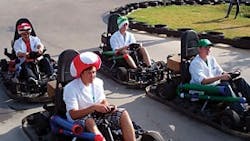Engineers and Their Life-Size Mario Karts
At NIWeek 2011, National Instruments showed off some of its capabilities through a larger-than-life version of Angry Birds called Angry Eagles. Now, NI has its hands in the life-size creation of another video game — this time Mario Kart.
Engineers at Waterloo Labs, which was started by NI engineers to create cowboy engineering projects, created a real-life, playable version of the game first played on Super Nintendo in the early '90s. With four NI CompactRIOs, servos, pneumatics, RFID tags and LabView system design software, the team converted ordinary go-karts into wirelessly controllable game karts.
The go-karts behave normally until an item is detected. The cRIO processes the signals from the RFID tags and outputs the signals to control the corresponding pneumatic valves and servo motors that control the movement of the go-kart. Steering is controlled with two pneumatic cylinders and the brake with one cylinder. The governor, or speed limiter, is controlled with two servo motors.


